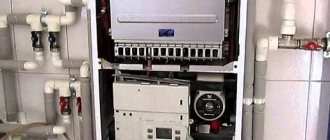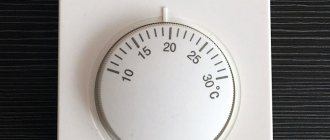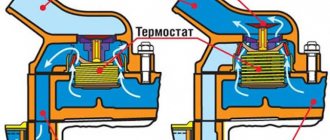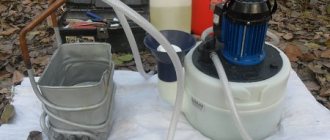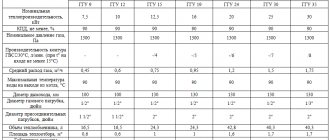Heating is one of the most important concerns for owners of private houses or premises.
Connection to centralized networks is not available to everyone, and high tariffs are pushing for the creation of autonomous systems.
Baksi heating boilers are one of the reliable and effective solutions to the problem, providing a complete replacement for network resources.
They are capable of providing a house or other premises with hot water, supplying coolant to a heating system or underfloor heating.
A useful feature of Baksi boilers is the ability to connect additional devices that improve the operating mode of the units.
What is a room thermostat and why is it needed for a gas boiler?
A thermostat is a device that maintains temperature at a certain, predetermined level..
It is used in many technical and technological installations where it is necessary to maintain certain environmental parameters.
Basically, thermostats are used in heating systems, in internal combustion engines, heating installations and other devices.
For a gas boiler, a thermostat serves as a convenient and useful addition. When the room reaches the desired temperature, it turns off the heating of the coolant, and when it drops, it starts the process again .
The specificity of the device’s operation is to control the temperature of the internal atmosphere in the room (some models simultaneously determine the external temperature, making additional adjustments to the operating mode when it changes).
Own sensors installed in boilers only monitor the temperature of the heating agent. Situations often arise when the coolant is heated to the required value, but the room is cool due to frequently opened doors, windows, etc.
To create a comfortable temperature, you have to often change the operating mode of the boiler, distracting yourself from your business to reconfigure. Using a thermostat relieves the owner of this concern; temperature correction is carried out automatically .
IMPORTANT! The thermostat allows you to save about 25-30% of space heating costs, which is very attractive for any owner.
General principles for connecting a thermostat
The method and diagrams for connecting the thermostat to the heating equipment itself can be found in the technical data sheet of the gas boiler. Modern equipment, regardless of manufacturer, requires connection points for the thermostat. The connection is made using the terminals on the boiler or the thermostat cable included in the delivery package.
If you are using a wireless thermostat, place the measuring unit only in a residential area. This may be the coldest room or the room where the largest number of people often gathers, the children's room.
It is not advisable to install a thermostat unit in the kitchen, hall or boiler room, where the temperature regime is unstable.
The thermostat should not be exposed to sunlight, it should not be located in a draft, near heating devices and electrical equipment that emit a large amount of heat - thermal interference has a bad effect on the operation of the device
Connecting different types and models of thermostats may have their own characteristics; installation is carried out in accordance with the manufacturer's instructions, which are included with the device.
Recommendations include a comprehensive description of the regulator's operation, connection method and diagrams. Next, we will tell you how to properly connect a thermostat to a gas boiler and about the installation features of the most typical regulator models.
Connecting a mechanical thermostat
The mechanical type thermostat is distinguished by its reliability and simplicity of design, low cost, and long-term operation.
However, it supports only one temperature mode, which is set by changing the position of the handle on the temperature scale mark. Most thermostats operate in the temperature range from 10 to 30°C.
To connect a mechanical thermostat to an air conditioner, use the NC terminal; to gas or any other heating equipment, use the NO terminal
The mechanical thermostat has the simplest principle of operation and is activated through an opening and breaking circuit, which occurs using a bimetallic strip. The thermostat is connected to the boiler through the terminal box on the boiler control board.
When connecting the thermostat, pay attention to the markings - they are present on almost all models. If there are no markings, use a tester: pressing one probe to the middle terminal, check the side terminals with the second and identify a pair of open contacts
Installation of an electronic thermostat
The design of an electronic thermostat requires the presence of an electronic board that is responsible for controlling the device.
The control signal is potential - voltage is transmitted to the boiler input, which leads to the closing or opening of the contact. A voltage of 220 or 24 volts must be supplied to the thermostat.
Electronic thermostats allow for more complex settings of the heating system. When connecting an electronic thermostat, the power wire and neutral are connected to it. The device transmits voltage to the boiler input, which starts the operation of the equipment
An electronically controlled thermostat is used to organize the operation of complex climate systems. It will help in controlling not only an atmospheric or turbine gas boiler, but also a pump, air conditioner, and servo drive in the heating system.
How to connect a wireless thermostat?
The wireless thermostat consists of two blocks, one of which is installed in a living room and acts as a transmitter. The second unit is mounted near the heating boiler and connected to its valve or controller.
Data transmission from one block to another is carried out over a radio channel. To control the device, the control unit is equipped with an LCD display and a small keyboard. To connect the thermostat, set the sensor address and install the unit at a point with a stable signal.
Thermostat connection diagram for an open circuit - the equipment turns on at the moment the current appears. A similar circuit is used when connecting a mechanical thermostat
The main disadvantage of a wireless thermostat is that the remote unit is powered by batteries, which have a limited resource and therefore require frequent replacement. To ensure uninterrupted operation, the device is equipped with an alarm function that warns when the battery needs to be replaced.
Principle of operation
A control board is installed inside the boiler, which controls all the actions of the unit components. It has special contacts, which by default are connected by a special jumper. They are used to connect the thermostat.
While the jumper is in place, the operation of the system is subject to its own logic - the coolant temperature is set, the boiler heats the heating agent to the specified parameters and turns off when they are reached until the water cools down to the lower limit.
When connecting the thermostat, the jumper is removed. The device turns out to be connected to the gap, so all control of the boiler operation passes to it. The work process becomes smoother, frequent starts and stops of heating stop. The air temperature changes more smoothly.
This method of control gives a more successful effect, allowing you to reduce gas consumption and seriously save on heating.
Main types of boilers and temperature control
There are several types of boilers: solid fuel, gas, electric and liquid fuel.
Boilers have become widespread throughout the world. There are domestic samples, and there are also imported boilers. Material of manufacture: steel or cast iron. Easy to use, economical, with the function of adjusting the coolant temperature. In cheaper models, this function is implemented using a special device - a thermoelement.
Structurally, a thermoelement is a metal product, the geometric dimensions of which decrease or increase under the influence of temperatures (depending on the degree of heating). And this, in turn, changes the position of a special lever that closes and opens the draft damper. The photo shows an example of such a regulator:
Photo: thermostat sample
The more the damper is open, the stronger the combustion process, and vice versa. Thus, the volume of air that enters the closed combustion chamber is completely controlled by the thermostat, and if necessary, its supply is stopped and the combustion process is extinguished. More modern models are equipped with controllers that, depending on the specified thermal conditions, control the air flow, turning on (or off) a special fan (see photo below):
Boiler with temperature controller
Gas boilers are the most common and cheapest units to operate. Boilers are single-circuit and double-circuit. Single-circuit boilers have one heat exchanger and are intended for heating only. The connection diagram is shown in the figure below:
Switching diagram for a single-circuit boiler
Double-circuit boilers have two heat exchangers and are designed for heating and producing hot water. The boiler switching diagram is presented below:
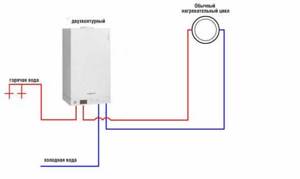
Switching diagram for a double-circuit boiler
Some boilers have separate controls for heating and hot water temperatures.
Kinds
There are many design options for room thermostats. For Baxi boilers, it is possible to use any of them, which is very convenient for users.
All types of thermostats can be divided according to individual characteristics:
Installation location
According to the installation location, all thermostats can be divided into indoor and outdoor (external). The first ones are mounted indoors, the second ones are placed outside and monitor the state of external weather and temperature conditions.
Most owners prefer to control the internal conditions of the premises, since they have a greater impact on the microclimate of the home. External devices are suitable for residents of southern regions, where the thermal insulation of walls is not so effective.
Control method
Existing control methods:
- Mechanical.
- Electronic.
- Remote.
The first version of the devices is based on changing the volumes of liquids or gases in closed containers with a membrane. These devices operate only in real (current) time and are not programmable.
Electronic thermostats are much more accurate than mechanical ones. The measuring instrument is a thermistor, which changes resistance as the temperature rises or falls . They have a high response rate and are capable of programming some time in advance.
Remote control is carried out using computers or smartphones. To do this, WiFi or GSM modules are installed in the device, providing remote communication between the user and the thermostat. Such models are the most expensive, but their capabilities are much wider than those of conventional models.
Principle of operation
Based on the principle of operation, devices are divided into mechanical and electronic. They operate on different principles described above.
The choice of one type or another is determined by the operating conditions and characteristics of the premises. The more accurately and more often it is necessary to adjust the operation of the boiler, the higher the need for electronic devices. If the operating mode is adjusted within small limits, it is possible to install a conventional mechanical thermostat.
Tips for DIYers
The benefits of installing a thermostat are obvious. The payback of the devices is also beyond doubt. Nevertheless, the desire to save money on installing such a useful device still remains strong. This often encourages home DIYers to do everything themselves. And not only to install the device yourself, but also to assemble it from scrap materials.
Installation process
Theoretically, it is possible to make a thermostat with your own hands. To do this, you will need a thermistor that reduces resistance when heated. Then another resistor is connected to the network, with the help of which the temperature will be programmed. The 2I-NOT element will operate in inverter mode, and voltage will be supplied to it. A capacitor is connected to it and to the trigger. To control the relay, the galvanic isolation on the triac is enhanced. The device can be made either on a mole rat or on a printed circuit board.
Using such a simple circuit, you can assemble a thermostat for almost any boiler. But is it worth interfering with the operation of high-tech equipment? It is up to the home owner to decide. Experts do not advise experimenting with homemade devices, especially since you can find accessories for any boiler on the market.
Additional useful options
Some thermostat models solve only basic problems without having any additional options.
More advanced samples, in addition to basic functions, are capable of performing some related actions that expand the capabilities and efficiency of the device. For example, in addition to monitoring room temperature, there are options for monitoring weather conditions outside and making adjustments to the heating mode in accordance with them.
In addition, there are other options:
- Several options for room thermal conditions.
- Programming individual settings.
- WiFi Internet access with the ability to remotely program the mode.
- GSM module for working with a smartphone via SMS.
- Protection against unauthorized mode changes (child lock).
- Decorative lighting.
- Protection against overheating or freezing.
- Hydrometer with the function of changing air humidity.
It is up to the owner of the thermostat to decide how necessary these functions are, since they are not available in all models. By choosing the most suitable option, you can immediately determine the list of required options and purchase the desired sample.
How to install correctly
Installing the device is not difficult. The main task is to choose the right location.
Experts recommend placing thermostats in living rooms, avoiding installation in hallways or kitchens.
Otherwise, the boiler begins to provide the microclimate of these particular areas of the house, and the temperature in the rooms is set with distortions.
The optimal installation height is considered to be 1.5 m from the floor, away from heating devices and household appliances that generate heat.
NOTE! It is necessary to ensure that there are no drafts in the control area and an even and steady flow of fresh air is ensured.
How to choose a Baxi thermostat
Thermostats and sensors for Baxi gas boilers are produced by the Italian company itself , so it is best to choose them. If this is not possible, you need to look for a thermostat that is suitable according to the parameters that are usually indicated in the technical data sheets of the devices. In such cases, it is appropriate to consult a specialist who is well acquainted with the Baxi brand.
Attention! Carefully check the compatibility of the thermostat with the gas boiler for which it is purchased. Remember that devices from the same company interact best with each other.
When choosing a thermostat, it is necessary to consider whether the boiler is used constantly or only occasionally. If the house has an inexpensive model of the unit that rarely works, then a simple regulator with a minimum of functions is enough.
Which to choose
Any thermostat model is suitable for working in conjunction with a Baxi boiler, but the optimal solution would be to choose a product from the same company.
Devices created by the same manufacturer have maximum compatibility and can demonstrate maximum operating efficiency . The limiting factor is the cost of the device.
If purchasing expensive models becomes a problem, you can use relatively cheap Chinese models.
They are fully functional and perform the task with sufficient accuracy..
The only drawback is unreliability and rapid failure of some devices.
Recommended models:
- Baxi Magictime Plus.
- Salus 091 FLRF.
- Siemens REV13.
- Cewal RQ30.
- Watts MILUX-HYDROSTAT.
When choosing a device, you need to clarify the list of its functions and capabilities. Most modern products have a very wide range of options that allow you to create a high-quality and comfortable microclimate in the house.
Device selection
The choice of device must be approached intelligently.
Often people buy a device with a considerable number of options that they then never use. What to consider? Let's look at this in more detail. A remote thermostat can be wired or wireless.
The presence of a wire eliminates the need for batteries, but such a connection will bring a lot of other problems when the device needs to be installed in an adjacent room. Laying a wire along the wall or drilling a through hole for it is not the best solution for a room after renovation (or if there are no plans to carry out renovations there in the near future). The wireless sensor not only does not require connection, but can also be moved to any other room
Even before purchasing, it is important to know the range of the device and how it works through walls. For example, some cheap sensors work reliably only in the line of sight, but if the situation changes or if they are far away, they may lose the ability to transmit a signal to a module installed near the boiler. Purchasing a device from the same company that manufactured the boiler will help you avoid some connection problems.
Boiler and thermostat from the same company

As already mentioned, it would be good if the device was purchased for an installed boiler from the same manufacturer. The most successful combination was achieved by the famous brands Baxi (baxi), Protherm (Proterm) and Vaillant (Vailant). In the illustrations below you can see the variety of these devices.
Vaillant

Adjustment method
Controls can be:
- in the form of buttons, and all data is displayed on an electronic display;
- Mechanical control implies the presence of a regulator with indicators printed on it.
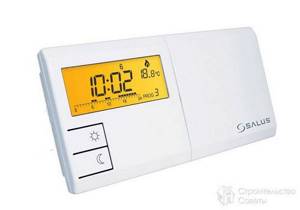
Thermostats can be simple or multifunctional.
- A simple device can only maintain the temperature in the room preset in its settings.
- The programmable thermostat has a rich set of functions. It can be configured by changing the boiler parameters remotely, setting the desired temperature conditions at different times of the day. You can also set settings for each day of the week.
- A thermostat with a built-in hydrostat function will allow you to control, maintain and change the microclimate of the room by changing the humidity level.
Technology
The connection is made with the boiler and thermostat turned off. According to the instructions for both devices, the corresponding jumper is removed from the control board, and a thermostat is connected to the contacts .
Technologically, this process does not present any difficulty, but for an unprepared person who is afraid to delve into the complex electronics of the equipment, it may seem impossible. In such cases, it is necessary to invite a specialist who can perform qualified installation and connection of the thermostat.
Usually work starts from the boiler:
- With the unit turned off, remove the protective cover to gain access to the control board.
- Remove the jumper on the corresponding contacts according to the instructions.
- Connect the ends of the connecting wire to them.
- The wire is pulled to the location where the thermostat is installed and secured to the wall.
- Connect the device itself, connect it to the power supply.
- Start and configure the operating mode.
IMPORTANT! It is recommended to entrust these actions to a specialist from the service center, otherwise conflict situations and denial of warranty service are possible.
Recommendations for use
In order for the heating system to operate economically and create maximum comfort in the home, the following recommendations should be taken into account:
- if all household members are at work or school for a long period, an economical operating mode can be programmed for this time;
- when leaving home for a long time, you need to set the heating to minimum and install new batteries;
- It is better to change the batteries in the programmer for new ones in advance, without waiting until they are completely discharged;
- It is advisable to connect a voltage stabilizer to the thermostat and gas boiler.
A thermostat is a useful device that will save money and create comfort and coziness in your home. It will make it easier to operate the gas boiler and extend its service life.
How to check the functionality of the device
The performance check is carried out after starting the system and setting the boiler operating mode to maximum efficiency.
Then you need to wait until the temperature rises to the most comfortable value and set it as the upper threshold.
Within an hour (sometimes it takes longer), the internal air temperature is monitored using a thermometer. The operating mode is considered normal if the device responds to a temperature drop within 0.5-2°.

